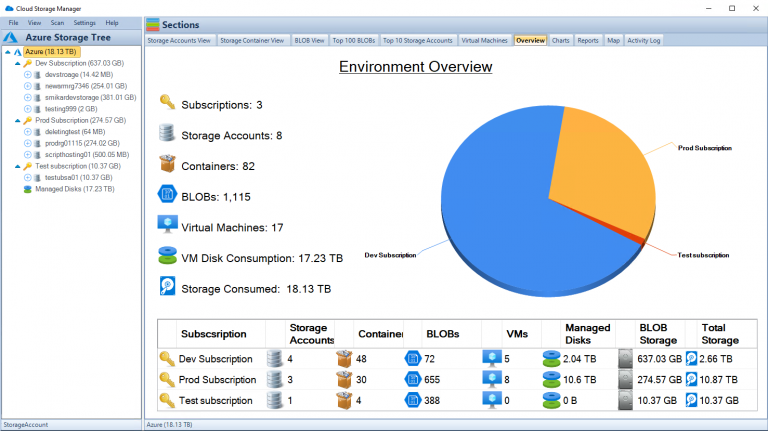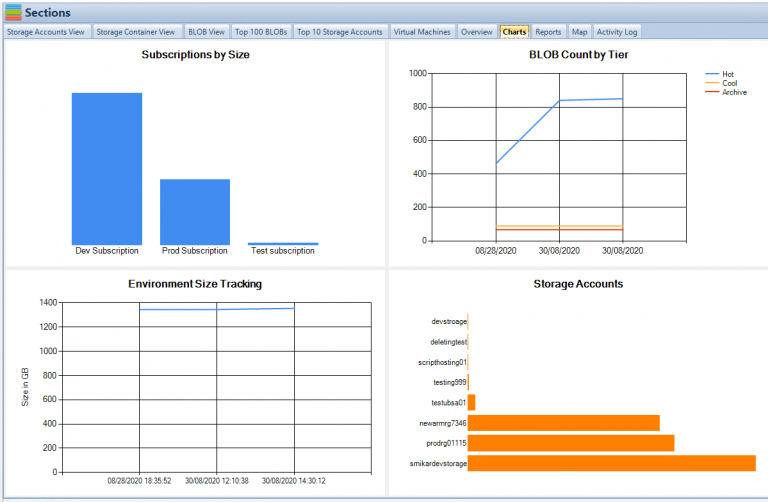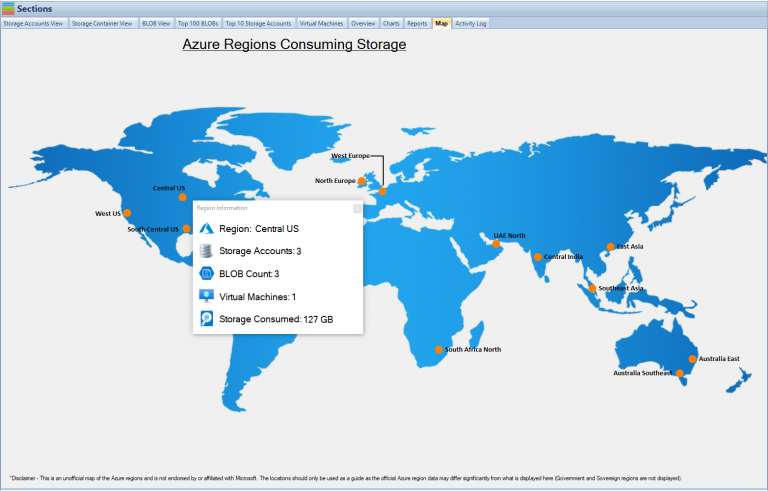Azure Blob storage is a versatile and scalable cloud-based storage solution that allows you to store and manage large amounts of unstructured data. It offers three types of Blobs – Block Blobs, Page Blobs, and Append Blobs – each designed for specific use cases. In this article, we will provide an in-depth exploration of Page Blobs, their features, advantages, use cases, and how you can manage them effectively using Cloud Storage Manager.
What are Page Blobs?
Page Blobs are a type of Azure Blob storage designed to store and manage large, random-access files. They are particularly suited for scenarios where you need to read and write small sections of a file without affecting the entire file. This is in contrast to Block Blobs, which are optimized for streaming large files and storing text or binary data. Page Blobs are organized as a collection of 512-byte pages and can store up to 8 TB of data.
Page Blob Features
Page Blobs offer several unique features, including:
- Random read-write access: Page Blobs provide efficient random read-write access, allowing you to quickly modify specific sections of a file without altering the entire file.
- Snapshots: Page Blobs support snapshot functionality, which enables you to create point-in-time copies of your data for backup or versioning purposes.
- Incremental updates: Page Blobs allow incremental updates, enabling you to modify only the changed portions of a file instead of rewriting the entire file, which can save storage space and improve performance.
- Concurrency control: Page Blobs support optimistic concurrency control, ensuring that multiple users can simultaneously access and modify a file without conflicts or data corruption.
Advantages of Page Blobs
Some of the key advantages of using Page Blobs include:
- Efficient random access: Page Blobs excel at providing efficient random read-write access, making them suitable for use cases like virtual hard disk (VHD) storage and large databases.
- Scalability: Page Blobs can store up to 8 TB of data, offering a scalable solution for storing and managing large files.
- Data protection: Page Blobs support snapshot functionality, providing a means to create point-in-time backups and versioning for your data.
- Optimized performance: With support for incremental updates, Page Blobs can help improve performance by reducing the need to rewrite entire files when only a small section has changed.
- Concurrency control: The optimistic concurrency control feature ensures that multiple users can work on a file simultaneously without conflicts or data corruption.
Use Cases for Page Blobs
Page Blobs are ideal for the following use cases:
- Virtual Hard Disk (VHD) storage: Page Blobs are commonly used to store VHD files for Azure Virtual Machines (VMs) due to their efficient random read-write access capabilities.
- Large databases: Page Blobs are suitable for storing large databases that require random access and frequent updates to small sections of data.
- Backup and versioning: With snapshot functionality, Page Blobs can be used for backup and versioning purposes in applications that require point-in-time data copies.
- Log files: Page Blobs can be used for storing log files that require frequent updates and random access to specific sections.
Comparing Page Blobs and Block Blobs
While both Page Blobs and Block Blobs are used for storing unstructured data, they have different characteristics and are optimized for different use cases:
- Size: Page Blobs can store up to 8 TB of data, while Block Blobs can store up to 4.75 TB.
- Access patterns: Page Blobs provide efficient random read-write access, making them ideal for VHD storage and large databases. In contrast, Block Blobs are optimized for streaming large files and are suitable for storing text or binary data, such as documents, images, and videos.
- Updates: Page Blobs support incremental updates, allowing you to modify only the changed portions of a file. Block Blobs require you to upload the entire file when making modifications.
- Pricing: Page Blobs are generally more expensive than Block Blobs due to their additional features and capabilities.
Pricing
Azure Blob storage pricing depends on factors such as data storage, transactions, and data transfer. For Page Blobs, you’ll be billed based on the total size of the provisioned pages, not the actual data stored. This means that even if you’re only using a portion of the provisioned pages, you’ll still be billed for the entire capacity. To optimize your storage costs, consider using Azure Blob Storage Reserved Capacity or implementing Azure Storage Retention Policies.
Managing Page Blobs with Cloud Storage Manager
Cloud Storage Manager is a powerful software solution that provides insights into your Azure Blob and File storage consumption. It offers various features to help you manage Page Blobs effectively:
Storage Usage Insights
Cloud Storage Manager provides detailed reports on your storage usage, enabling you to identify trends and optimize your storage consumption.
Growth Trend Reports
With Cloud Storage Manager, you can generate growth trend reports that help you understand how your storage needs are evolving over time. This information can be invaluable for planning and budgeting purposes.
Cost Optimization
Cloud Storage Manager helps you save money on your Azure Storage by providing recommendations on how to optimize your storage usage, such as cost-effective tips for Azure Blob Storage
Securing Page Blobs
Securing your data is critical when using cloud storage services like Azure Blob Storage. To protect your Page Blobs, you should implement the following security best practices:
- Use Azure Active Directory (AD) authentication: Configure Azure AD authentication to control access to your Page Blobs, ensuring that only authorized users and applications can access your data.
- Implement Role-Based Access Control (RBAC): Use RBAC to assign specific permissions to users and groups, limiting their access and actions on your Page Blobs based on their roles and responsibilities.
- Enable encryption: Use Azure Storage Service Encryption (SSE) to encrypt your Page Blobs at rest. This ensures that your data is protected against unauthorized access and disclosure.
- Monitor and audit: Regularly monitor and audit your Page Blob activity using Azure Monitor and Azure Storage Analytics. This helps you identify and respond to potential security threats and maintain compliance with data protection regulations.
Migrating to and from Page Blobs
Migrating data between different types of Blob storage, such as from Block Blobs to Page Blobs or vice versa, requires careful planning and execution. You can use the Azure Data Factory or the AzCopy command-line utility to transfer data between different Blob storage types.
Using Page Blobs with Azure Premium Storage
Azure Premium Storage is a high-performance storage option designed for virtual machine (VM) workloads that require low-latency and high IOPS. Page Blobs stored on Premium Storage can deliver up to 60,000 IOPS and 2,000 MB/s of throughput per disk, making them ideal for hosting VM disks and high-performance databases.
Page Blob Performance Optimization
To optimize the performance of your Page Blobs, consider the following best practices:
- Use Premium Storage: If your workload demands high IOPS and low latency, consider using Page Blobs with Azure Premium Storage.
- Optimize access patterns: Design your application to read and write data in a way that takes advantage of Page Blobs’ efficient random access capabilities.
- Cache frequently accessed data: Use Azure Redis Cache or Azure Content Delivery Network (CDN) to cache frequently accessed data, reducing latency and improving performance.
- Use multiple storage accounts: Distribute your Page Blobs across multiple storage accounts to increase throughput and avoid hitting the IOPS and bandwidth limits of a single account.
Frequently Asked Questions
- What is the maximum size of a Page Blob?Page Blobs can store up to 8 TB of data.
- What is the difference between Page Blobs and Block Blobs?Page Blobs are designed for efficient random read-write access and are suitable for VHD storage and large databases, while Block Blobs are optimized for streaming large files and storing text or binary data such as documents, images, and videos.
- Can I convert a Block Blob to a Page Blob or vice versa?Yes, you can use tools like Azure Data Factory or AzCopy to migrate data between Block Blobs and Page Blobs.
- How can I optimize the performance of my Page Blobs?To optimize Page Blob performance, consider using Premium Storage, optimizing access patterns, caching frequently accessed data, and distributing your Page Blobs across multiple storage accounts.
- What are the best practices for securing Page Blobs?To secure your Page Blobs, use Azure Active Directory authentication, implement Role-Based Access Control, enable encryption using Azure Storage Service Encryption, and regularly monitor and audit your Page Blob activity.
- What is the cost of using Page Blobs?Azure Blob storage pricing depends on factors such as data storage, transactions, and data transfer. For Page Blobs, you’ll be billed based on the total size of the provisioned pages, not the actual data stored.
- How can I manage my Page Blobs effectively?Use a software solution like Cloud Storage Manager to gain insights into your storage usage, generate growth trend reports, and optimize your storage costs.
- What are some common use cases for Page Blobs?Page Blobs are ideal for use cases such as virtual hard disk storage, large databases, backup and versioning, and log file storage.
Conclusion
Page Blobs are a powerful and versatile cloud storage solution that provides efficient random read-write access, making them ideal for storing and managing large files such as virtual hard disks and databases. By understanding the unique features and advantages of Page Blobs, you can make informed decisions about your cloud storage strategy and effectively manage your data using tools like Cloud Storage Manager.
Whether you’re migrating to Page Blobs, optimizing their performance, or securing your data, following best practices will help you get the most out of your Azure Blob Storage investment.




